
Left: mLg computed using the IASPEI formula. Center: mLg residuals versus epicentral distance ; the values used for the trimmed mean magnitude estimate are indicated. Right: residuals as a function of distance and azimuth.
The ANSS event ID is tx2025lbso and the event page is at https://earthquake.usgs.gov/earthquakes/eventpage/tx2025lbso/executive.
2025/06/07 11:02:39 31.675 -104.388 6.1 3.3 Texas
USGS/SLU Moment Tensor Solution
ENS 2025/06/07 11:02:39.0 31.67 -104.39 6.1 3.3 Texas
Stations used:
4O.BP01 4O.CT01 4O.CT02 4O.CV01 4O.SA02 4O.SA04 4O.SA07
4O.WB02 4O.WB03 4O.WB04 4O.WB05 4O.WB07 4O.WB08 4O.WB09
4O.WB11 4O.WW01 TX.PB01 TX.PB09 TX.PB10 TX.PB11 TX.PB12
TX.PB13 TX.PB23 TX.PB24 TX.PB25 TX.PB26 TX.PB28 TX.PB29
TX.PB31 TX.PB33 TX.PB34 TX.PB39 TX.PB40 TX.PB43 TX.PB44
TX.PECS
Filtering commands used:
cut o DIST/3.3 -30 o DIST/3.3 +30
rtr
taper w 0.1
hp c 0.05 n 3
lp c 0.25 n 3
Best Fitting Double Couple
Mo = 8.51e+20 dyne-cm
Mw = 3.22
Z = 7 km
Plane Strike Dip Rake
NP1 100 60 -90
NP2 280 30 -90
Principal Axes:
Axis Value Plunge Azimuth
T 8.51e+20 15 190
N 0.00e+00 -0 100
P -8.51e+20 75 10
Moment Tensor: (dyne-cm)
Component Value
Mxx 7.15e+20
Mxy 1.26e+20
Mxz -4.19e+20
Myy 2.22e+19
Myz -7.39e+19
Mzz -7.37e+20
##############
######################
############################
#######-------------##########
#####----------------------#######
###---------------------------######
##--------------------------------####
#-----------------------------------####
------------------- ----------------##
#------------------- P -----------------##
###----------------- -----------------##
#####------------------------------------#
#######----------------------------------#
#########------------------------------#
##############---------------------#####
######################################
####################################
##################################
##############################
######### ################
###### T #############
## #########
Global CMT Convention Moment Tensor:
R T P
-7.37e+20 -4.19e+20 7.39e+19
-4.19e+20 7.15e+20 -1.26e+20
7.39e+19 -1.26e+20 2.22e+19
Details of the solution is found at
http://www.eas.slu.edu/eqc/eqc_mt/MECH.NA/20250607110239/index.html
|
STK = 280
DIP = 30
RAKE = -90
MW = 3.22
HS = 7.0
The NDK file is 20250607110239.ndk The waveform inversion is preferred.
Given the availability of digital waveforms for determination of the moment tensor, this section documents the added processing leading to mLg, if appropriate to the region, and ML by application of the respective IASPEI formulae. As a research study, the linear distance term of the IASPEI formula for ML is adjusted to remove a linear distance trend in residuals to give a regionally defined ML. The defined ML uses horizontal component recordings, but the same procedure is applied to the vertical components since there may be some interest in vertical component ground motions. Residual plots versus distance may indicate interesting features of ground motion scaling in some distance ranges. A residual plot of the regionalized magnitude is given as a function of distance and azimuth, since data sets may transcend different wave propagation provinces.

Left: mLg computed using the IASPEI formula. Center: mLg residuals versus epicentral distance ; the values used for the trimmed mean magnitude estimate are indicated.
Right: residuals as a function of distance and azimuth.

Left: ML computed using the IASPEI formula for Horizontal components. Center: ML residuals computed using a modified IASPEI formula that accounts for path specific attenuation; the values used for the trimmed mean are indicated. The ML relation used for each figure is given at the bottom of each plot.
Right: Residuals from new relation as a function of distance and azimuth.

Left: ML computed using the IASPEI formula for Vertical components (research). Center: ML residuals computed using a modified IASPEI formula that accounts for path specific attenuation; the values used for the trimmed mean are indicated. The ML relation used for each figure is given at the bottom of each plot.
Right: Residuals from new relation as a function of distance and azimuth.
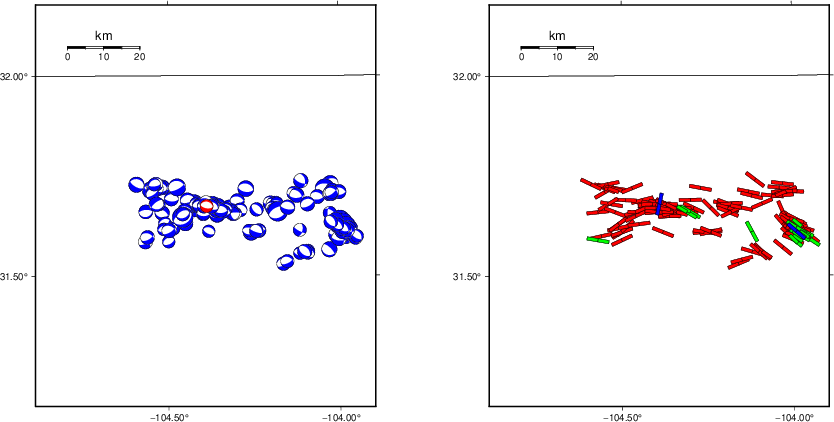 |
The focal mechanism was determined using broadband seismic waveforms. The location of the event (star) and the stations used for (red) the waveform inversion are shown in the next figure.
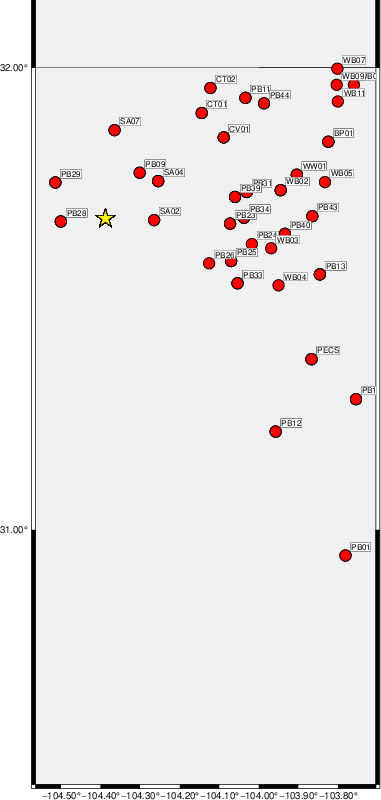
|
|
|
The program wvfgrd96 was used with good traces observed at short distance to determine the focal mechanism, depth and seismic moment. This technique requires a high quality signal and well determined velocity model for the Green's functions. To the extent that these are the quality data, this type of mechanism should be preferred over the radiation pattern technique which requires the separate step of defining the pressure and tension quadrants and the correct strike.
The observed and predicted traces are filtered using the following gsac commands:
cut o DIST/3.3 -30 o DIST/3.3 +30 rtr taper w 0.1 hp c 0.05 n 3 lp c 0.25 n 3The results of this grid search are as follow:
DEPTH STK DIP RAKE MW FIT
WVFGRD96 1.0 240 45 5 2.49 0.1161
WVFGRD96 2.0 250 35 20 2.78 0.1737
WVFGRD96 3.0 110 70 -70 2.93 0.2951
WVFGRD96 4.0 100 65 -80 3.04 0.4328
WVFGRD96 5.0 100 60 -85 3.11 0.5304
WVFGRD96 6.0 100 60 -90 3.17 0.5830
WVFGRD96 7.0 280 30 -90 3.22 0.5956
WVFGRD96 8.0 100 65 -90 3.33 0.5764
WVFGRD96 9.0 100 65 -90 3.36 0.5486
WVFGRD96 10.0 100 65 -90 3.38 0.5009
WVFGRD96 11.0 105 65 -90 3.39 0.4423
WVFGRD96 12.0 110 65 -85 3.39 0.3870
WVFGRD96 13.0 115 65 -80 3.39 0.3366
WVFGRD96 14.0 115 65 -85 3.39 0.2959
WVFGRD96 15.0 120 70 -80 3.38 0.2659
WVFGRD96 16.0 270 30 60 3.39 0.2484
WVFGRD96 17.0 80 30 55 3.35 0.2475
WVFGRD96 18.0 80 30 50 3.36 0.2612
WVFGRD96 19.0 285 55 -75 3.39 0.2739
WVFGRD96 20.0 280 50 -80 3.41 0.2880
WVFGRD96 21.0 275 50 -85 3.43 0.3046
WVFGRD96 22.0 275 50 -85 3.44 0.3175
WVFGRD96 23.0 275 50 -85 3.45 0.3305
WVFGRD96 24.0 275 50 -85 3.46 0.3361
WVFGRD96 25.0 275 50 -85 3.46 0.3367
WVFGRD96 26.0 280 50 -85 3.46 0.3376
WVFGRD96 27.0 285 45 -85 3.45 0.3354
WVFGRD96 28.0 90 35 55 3.44 0.3391
WVFGRD96 29.0 90 35 55 3.45 0.3421
The best solution is
WVFGRD96 7.0 280 30 -90 3.22 0.5956
The mechanism corresponding to the best fit is
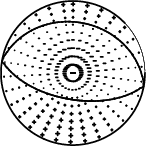
|
|
|
The best fit as a function of depth is given in the following figure:
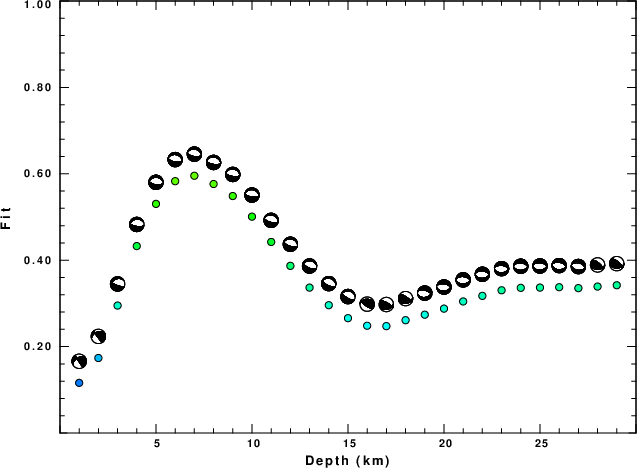
|
|
|
The comparison of the observed and predicted waveforms is given in the next figure. The red traces are the observed and the blue are the predicted. Each observed-predicted component is plotted to the same scale and peak amplitudes are indicated by the numbers to the left of each trace. A pair of numbers is given in black at the right of each predicted traces. The upper number it the time shift required for maximum correlation between the observed and predicted traces. This time shift is required because the synthetics are not computed at exactly the same distance as the observed, the velocity model used in the predictions may not be perfect and the epicentral parameters may be be off. A positive time shift indicates that the prediction is too fast and should be delayed to match the observed trace (shift to the right in this figure). A negative value indicates that the prediction is too slow. The lower number gives the percentage of variance reduction to characterize the individual goodness of fit (100% indicates a perfect fit).
The bandpass filter used in the processing and for the display was
cut o DIST/3.3 -30 o DIST/3.3 +30 rtr taper w 0.1 hp c 0.05 n 3 lp c 0.25 n 3

|
| Figure 3. Waveform comparison for selected depth. Red: observed; Blue - predicted. The time shift with respect to the model prediction is indicated. The percent of fit is also indicated. The time scale is relative to the first trace sample. |

|
| Focal mechanism sensitivity at the preferred depth. The red color indicates a very good fit to the waveforms. Each solution is plotted as a vector at a given value of strike and dip with the angle of the vector representing the rake angle, measured, with respect to the upward vertical (N) in the figure. |
A check on the assumed source location is possible by looking at the time shifts between the observed and predicted traces. The time shifts for waveform matching arise for several reasons:
Time_shift = A + B cos Azimuth + C Sin Azimuth
The time shifts for this inversion lead to the next figure:
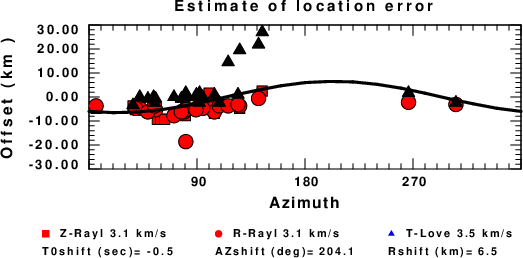
The derived shift in origin time and epicentral coordinates are given at the bottom of the figure.
The WUS.model used for the waveform synthetic seismograms and for the surface wave eigenfunctions and dispersion is as follows (The format is in the model96 format of Computer Programs in Seismology).
MODEL.01
Model after 8 iterations
ISOTROPIC
KGS
FLAT EARTH
1-D
CONSTANT VELOCITY
LINE08
LINE09
LINE10
LINE11
H(KM) VP(KM/S) VS(KM/S) RHO(GM/CC) QP QS ETAP ETAS FREFP FREFS
1.9000 3.4065 2.0089 2.2150 0.302E-02 0.679E-02 0.00 0.00 1.00 1.00
6.1000 5.5445 3.2953 2.6089 0.349E-02 0.784E-02 0.00 0.00 1.00 1.00
13.0000 6.2708 3.7396 2.7812 0.212E-02 0.476E-02 0.00 0.00 1.00 1.00
19.0000 6.4075 3.7680 2.8223 0.111E-02 0.249E-02 0.00 0.00 1.00 1.00
0.0000 7.9000 4.6200 3.2760 0.164E-10 0.370E-10 0.00 0.00 1.00 1.00